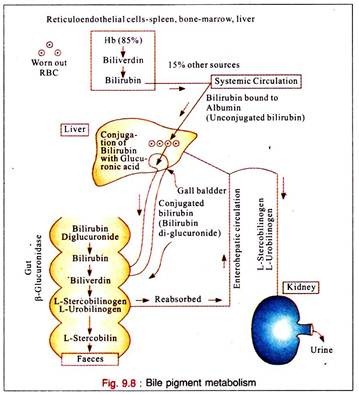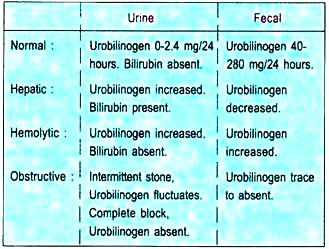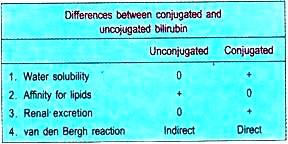In this essay we will discuss about Jaundice:- 1. Meaning of Jaundice 2. Causes of Jaundice 3. Types.
Essay on the Meaning of Jaundice:
It is defined as yellowish discolouration of the skin and mucous membrane due to excess amount of bilirubin present in blood.
Latent Jaundice:
Normal serum bilirubin level is 0.3 – 1.1 mg/ dl.
Clinical jaundice is evident when serum bilirubin crosses 2.5 mg/dl.
Jaundice is latent—i.e. clinically non evident (only detected by serum analysis)—when serum bilirubin level is in between 1 – 2.5 mg/dl. It is found in mitral stenosis, myocardial infarction, cirrhosis of liver, pernicious anemia, congestive cardiac failure, etc.
Essay on the Causes of Jaundice:
i. Production of more bile pigment than the normal liver can excrete or the failure of a damaged liver to excrete the bilirubin produced in normal amounts.
ii. Obstruction of the excretory ducts of the liver by preventing the excretion of bilirubin.
Essay on the Types of Jaundice:
A. Hemolytic Jaundice:
If the concentration of bilirubin in the serum rises above normal due to more formation as a result of increased erythrocyte destruction, hemolytic jaundice results. There is lemon-yellow tinge of bulbar conjunctiva.
Examples of Haemolytic jaundice:
(i) Thalassaemia
(ii) Mismatched blood transfusion
(iii) Snake bite
(iv) Malaria
(v) Rh incompatibility
(vi) Primaquine or sulphonamide induced (in G6PD deficiency).
Findings in hemolytic jaundice:
i. Blood:
(a) Hemoglobin level is decreased.
(b) Reticulocyte count is increased.
(c) Polychromatic macrocytes and fragmented red cells are present.
(d) Red cells are more fragile by osmotic fragility test.
(e) Prothrombin level is not prolonged.
(f) Coombs’ test is positive.
(g) Red colour does not appear unless methyl alcohol is added to the urine (bilirubin + diazo reagent) by van den Bergh test which indicates the presence of unconjugated bilirubin in serum.
ii. Urine:
(a) Prowine colour is produced.
(b) Bile pigment is absent but urobilinogen is abundantly present.
(c) No microscopical change.
(d) Acholuric urine, i.e. freshly passed urine is of normal colour as there is no bilirubin present in urine but if the urine sample is kept for some time, it turns dark yellow due to conversion of urobilinogen to urobilin (by odixation).
iii. Stool:
(a) The colour of stool becomes dark brown.
(b) Stercobilinogen or stercobilin is richly present.
B. Obstructive Jaundice:
This condition occurs from blockage of the hepatic or common bile ducts. The bile pigment passes from blood to the liver cells as usual. However, failing to be excreted by the bile capillaries, it is absorbed into the hepatic veins and lymphatic’s.
The usual causes of obstruction are:
i. Blocking of the bile passage by gallstones.
ii. Obstruction caused by enlarged glands, tumour of the head of the pancreas.
iii. Narrowing of the bile duct as a result of surgery.
In obstructive jaundice, the bulbar conjunctiva turns greenish yellow due to oxidation of bilirubin to biliverdin (green).
Examples of obstructive jaundice:
(I) Intrahepatic (medical):
i. Viral hepatitis.
ii. Chronic active hepatitis
iii. Cirrhosis of liver
iv. Drugs.
(II) Extra-hepatic (surgical):
(i) Gallstone impaction in common bile duct
(ii) Carcinoma of head of pancreas
(iii) Carcinoma of gall bladder
(iv) Stricture of common bile duct.
Important findings in obstructive jaundice:
i. Blood:
(a) Target cells are present.
(b) Prothrombin time is prolonged but this becomes normal after injection of vitamin K.
(c) Red colour is developed by van den Bergh test.
(d) Serum alkaline phosphatase level is increased.
ii. Urine:
(a) Mustard oil colour is formed.
(b) Bile pigments are abundantly found but urobilinogen is absent.
(c) No microscopical change.
iii. Stool:
Clay-coloured stools due to the absence of stercobilinogen.
Other findings of obstructive jaundice:
a. Generalized pruritus with scratch mark and shiny nails (bile acids irritate the nerve endings).
b. Sinus bradycardia — bile salts inhibit SA node.
c. Gall bladder may be palpable.
d. Prolonged obstructive jaundice may produce osteomalacia, bone pain, bone fracture, night blindness due to deficiency of Vit. A or Vit. D deficiency, respectively (due to malobsorption or steatorrhoea). These types of bony changes in this jaundice is known as hepatic osteodystrophy.
C. Hepato Cellular Jaundice:
This type of jaundice is caused by liver dysfunction as a result of the damage to the parenchymal cells by infection, toxins and liver poisons. At a certain stage, the inflammation and damage to liver cells become severe leading to partial obstruction to the flow of bile. This results in the absorption of conjugated bilirubin and bile into the general circulation. Orange-yellow tinge of bulbar conjunctiva.
Examples of Hepato cellular jaundice:
(i) Viral hepatitis (Type A, B, C commonly)
(ii) Drugs — Rifampicin
(iii) Poison — CuSO4
(iv) Pregnancy — Acute fatty liver of pregnancy
(v) Alcoholic hepatitis
(vi) Weil’s disease.
Important findings:
i. Blood:
(a) Increased levels of both conjugated and unconjugated bilirubin in serum.
(b) Prothrombin time is prolonged but remains high after administration of vitamin K.
(c) Increased SGPT activity.
(d) Highly positive flocculation tests.
ii. Urine:
(a) Highly coloured urine due to the presence of conjugated bilirubin and urobilinogen.
(b) Leptospira may be present.
On the basis of the type of plasma bilirubin i.e. unconjugated bilirubin or conjugated bilirubin, the hyperbilirubinemia may be classified as retention hyperbilirubinemia or regurgitation hyperbilirubinemia.
Bile salts and Bile acids:
(A) Bile salts — Sodium taurocholate and Sodium glycocholate,
(B) Bile acids —
a. Primary → cholic acid and chenodeoxycholic acid
b. Secondary → Deoxycholic acid and lithocholic acid.
c. Tertiary → Ursodeoxycholic acid.
Body secretions where bilirubin is found (in jaundice):
i. Found in body fluids like CSF, joint fluid, cyst.
ii. Absent from true secretions like tears, saliva, pancreatic juice.
Unilateral jaundice:
i. In patients with hemiplegia
ii. In presence of unilateral oedema.
Sites to be examined in jaundice patient:
The patient should be observed in front of an open window:
i. Upper bulbar conjunctiva (sclera is examined by retracting the upper eyelids upwards and asking the patient to look downwards — both eyes at a time).
ii. Undersurface of tongue.
iii. Soft palate.
iv. Palms and soles.
v. General skin surface.
Van den Bergh test:
This test helps in differentiation of hyperbilirubinaemia due to accumulation of conjugated bilirubin from unconjugated bilirubin.
Principle of the test:
Conjugated bilirubin or soluble bilirubin + Ehrlich’s diazo reagent → gets diazotized and develops azobilirubin which is coloured red.
Conjugated bilirubin develops red colouration immediately and it is water-soluble.
Unconjugated bilirubin being water-insoluble develops the colour only after addition of methyl alcohol to make it soluble.
Method:
1 ml clear serum (not hemolysed) is taken in a test tube. 0.5 ml Ehrlich’s working reagent is added by side of the test tube. Development of red coloured ring at the junction is indicative of direct positive reaction.
If no colour change takes place then 3 ml methyl alcohol is added and well-shaken. Development of red colour indicates indirect positive reaction.
If red colour develops immediately and it depends on addition of methyl alcohol the reaction is biphasic.
Interpretation of the result of van den Bergh test:
Nonnal serum — Negative.
Obstructive jaundice — Direct positive.
Hemolytic jaundice — Indirect positive.
Hepatocellular jaundice— Biphasic positive.
A. Crigler-Najjar Syndrome, Type I; Congenital Non-hemolytic jaundice:
i. It is a rare recessive disorder of humans owing to a primary metabolic defect in the conjugation of bilirubin which is involved in the inherited absence of bilirubin UDP-Glucuronyl transferase activity in hepatic tissues.
ii. The disease is usually alarming within the first fifteen months of life. But a few teenagers did not develop difficulties until puberty. These children have been treated with phototherapy with some reduction in plasma bilirubin levels.
iii. Phenobarbital and other drugs have no effect on the formation of bilirubin glucuronides in patients with this syndrome.
iv. Serum bilirubin usually exceeds 20 mg/ dL on un-treatment.
B. Crigler-Najjar Syndrome, Type II:
i. This rare inherited disorder is caused by a milder defect in the bilirubin conjugated system.
ii. The serum bilirubin level does not exceed 20 mg/dL. All of the bilirubin accumulated is of unconjugated type. The bile in these patients contains bilirubin monoglucuronide.
iii. Patients with this syndrome respond to large doses of Phenobarbital.
iv. This syndrome is the homozygous state of the defect present in heterozygous form in the mild chronic hyperbilirubinemia of Gilbert.
C. Gibert’s Disease:
i. It is a heterozygous group of disease many of which are due to a compensated hemolysis associated with unconjugated hyperbilirubinemia.
ii. There is defect in the hepatic clearance of bilirubin due to a defect in the uptake of bilirubin by the liver parenchymal cells.
iii. The bilirubin UDP-Glucuronyl transferase activities in the liver are found to be reduced.
D. Toxic hyperbilirubinemia:
i. Unconjugated hyperbilirubinemia results from liver dysfunction caused by chloroform, carbon tetrachloride, hepatitis virus, and cirrhosis.
ii. There is a component of obstruction of the biliary tree within the liver which results in the presence of some conjugated hyperbilirubinemia.
Conjugated Bilirubin passes into urine:
Since conjugated bilirubin is water-soluble it is detectable in the urine of most patients suffering from conjugated hyperbilirubinemia. They are frequently said to have chohiric jaundice.
The commonest causes of this condition are:
i. Chronic idiopathic jaundice (Dubin-Johnson syndrome):
(a) This syndrome happens in childhood or during adult life.
(b) This is caused by the defect in the hepatic secretion of conjugated bilirubin into the bile.
(c) The hepatocytes in the centrilobular area contain an abnormal pigment in patients with this syndrome.
ii. Biliary Tree obstruction:
(a) The blockage of the hepatic or common bile duct produces conjugated hyperbilirubinemia.
(b) The bile pigments pass from the blood into the liver cells but fails to be excreted. As a result, the conjugated bilirubin is absorbed into the hepatic veins and lymphatic’s.
(c) The term cholestatic jaundice is used to include all forms of extra-hepatic obstructive jaundice that are characterized by conjugated hyperbilirubinemia.


